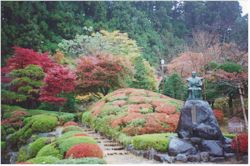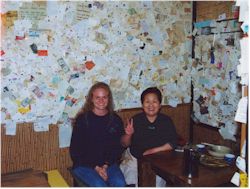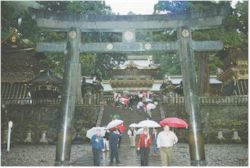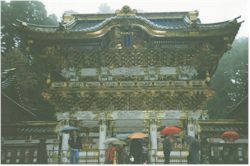| Nikko[links] |
November 2, 2000 |
||
Before I get to the Nikko stuff, I have to relate an experience I had in Tokyo. It was the morning of our visit to Nikko, and since we had a hotel reserved for the next night, I decided to go over to Intel Japan and pick up a bag I had stored there (it had my work stuff in it). The next day was a National Holiday, so I figured I should pick the bag up to make sure it got home with us. Anyway, our hotel was in the Ueno district of Tokyo, so I happened to be in Ueno station at 8:30am. Oh. My. Word, but that place was slammed! I got up to the platform to jump on the Yamanote Line (a loop around downtown Tokyo, and it was pretty crowded. The train pulled in and thousands of people disembarked. Then thousands of people embarked! I stood there in rapt amazement as it filled all the way to the gills. There was one little man, probably about sixty years old, in a brown suit, left on the outside. Well, his feet were outside, anyway. His upper body was thrust into the crowd, his legs pushing with all their might, like a battering ram. Just as the door closed, he pulled his feet in. I couldn't believe my eyes! I figured I was fortunate not to have tried getting on that train, and I was first in line for the next one. So, when the next one pulled up, I got on and was quickly forced to the back of the car by the force of another enormous herd of bodies. I had people literally sandwiched around me from all directions. Old men, middle ages women, teenaged girls and boys. Nobody seemed to mind the lack of personal space. I even noticed one person sleeping as we got moving, standing up! Not quite like riding the commuter lightrail in Portland, where nobody wants to sit next to anyone else! Anyway, after retrieving the bag, I headed back to the hotel on a much less crowded train, picked up Elaine, and we headed to Nikko via Utsonomiya. I thought it very interesting that the place we transferred to Nikko was named after the nice man who helped us in Kyoto. Okay, maybe he was named after the city... Nikko was cold and damp like Takayama, but it was still a worthwhile experience. The only reason to go to Nikko is to see the Toshogu Shrine. For anyone who has read James Clavell's Shogun, you'll remember the main Japanese character as Lord Toranaga. That character was based on the historical figure of Tokugawa Ieyasu, the first Tokugawa shogun, who took the title at the turn of the 17th century. The Tokugawa family retained rule of Japan for 250 years. The wealth and power of the family were enormous, as evidenced by the shrine we visited in Nikko. Tokugawa Iemitsu, grandson of Tokugawa Ieyasu (and third Tokugawa shrine - "mitsu" means "three"), built the shrine in honor of his grandfather. Most shrines in Japan are fairly unremarkable. Beautiful, yes, but mostly they are quite simple. Not so with the Tokugawa Shrine. The opulence of the shrine is staggering.
The main gate is popularly known as the "Twilight Gate", because it is so intricately carved and painted, that one could stare at it all day (until twilight) and not see all of the images on it. It was extremely cool. We wandered around the shrine, taking in the sights, and then headed up to the mausoleum. After the excess of the main shrine area, the tomb itself was fairly plain. It was quite dark by that time, and we really didn't get a good picture of it. On our way back to the train station, we found a little restaurant where I would eat every day if I could. It was fantastic. We figured this was the place to eat, since handwritten signs in English outside advised us not to miss it. When we walked in, we knew it was the right thing to do. It's called "Hippari Tako", and it's run by a cute little old lady named Miki-san. She takes the orders, does the cooking, and serves the tables.
Miki-san is a gracious and friendly host, and isn't afraid to rattle at you in Japanese whether you understand or not. I was able to catch most of her questions, asking where we were from and was this our first time in Japan, and where else in Japan had we been, and how she pretty much never leaves Nikko. I took a picture of Elaine and Miki-san, and we were on our way.
We headed back to Tokyo and grabbed dinner at a fun Mexican place called the "Zest Cantina." We noticed again how serving sizes in Japan are very reasonable, as contrasted to the outrageously large servings you get in the States. So, one more quick stay...in Tokyo... Nikko Links: [ Main Page ] |
|||
 The entrance to the extremely large shrine. The fall colors were spectacular. |
|||
|
Again, a torii gate leading to the shrine. It was quite a busy place. |
|||
|
The extremely opulent main gate to the shrine. This thing was decked out with intricate carvings and a lot of gold. |
|||
|
This stable housed the sacred white horse. Above the doorway was a very familiar sculpture of three monkeys in the "See no evil, etc" poses. Monkeys were thought to protect horses from disease. |
|||

Oh, the memory of the chicken meatballs in this place. Yum! Check out the walls, covered with business cards, notes, and foreign bills. |
|||
|


